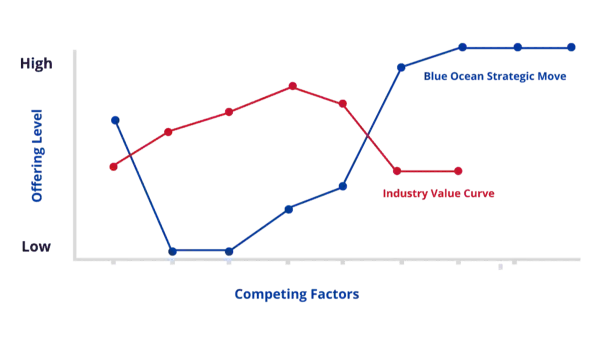Red Ocean Strategy and Blue Ocean Strategy Meaning
The blue ocean strategy is a unique business model that compels organisations to break away from the cut-throat competitive landscape. This intense competitive zone is referred to as the ‘red ocean’, whereas competition-free (or uncontested) markets are ‘blue oceans’. But how will the landscape look like if businesses implement the blue ocean strategy in Malaysia?
This business strategy, coined by W. Chan Kim and Renée Mauborgne, encourages companies to make the competition irrelevant. This is done by creating a leap in value for both the organisation and its customers. Instead of struggling in a saturated market, businesses can innovate and explore new opportunities that are ripe for growth.
The basis of the blue ocean strategy is the simultaneous pursuit of differentiation and low cost. This results in the creation of a new, unique market space.
Instead of beating the competition, the idea is to make the competition irrelevant. It generates new demand instead of exploiting existing demand. It is a transformative roadmap that redefines limits. Ultimately, this strategy ventures beyond the traditional boundaries of industries and competitors.
Understanding Malaysia’s Business Environment
Malaysia has a multifaceted business environment that commands global attention. The Southeast Asian nation has undergone a radical transformation since gaining independence in 1957. Today, it boasts a robust economy fueled by a diverse blend of industries including manufacturing, services, and agriculture. Moreover, Malaysia’s impressive infrastructure and its growing, educated workforce have created a favourable space for both local and foreign businesses.
On another note, the country is faced with intense competition from neighbouring countries, pushing businesses to constantly innovate to maintain competitiveness. Hence, a growing number of businesses are pivoting towards the blue ocean strategy in Malaysia; to break away from intense competition.
However, economic imbalances remain, and uneven regional development often sidelines rural areas in favour of urban centres. The regulatory environment, while improving, rates lower than regional peers on the ease of doing business
Blue Ocean Strategy Malaysia: Malaysian Businesses Adopts its Principles
In recent times, a significant number of Malaysian corporations have begun incorporating blue ocean strategy principles into their operations. This strategy is designed to enable businesses to carve out new, uncontested market spaces instead of battling in blood-red ‘red oceans’. It involves creating demand in a previously unoccupied market space and entailing the ability to align the entire system of a firm’s activities with the strategic choice of differentiation and low cost.
Malaysian businesses are increasingly recognizing the merits of this strategy as the nation’s economy matures, and businesses seek to distinguish themselves in a crowded marketplace. Companies such as AirAsia and Grab have shown remarkable success in implementing the blue ocean strategy in Malaysia, marking them as disruptive forces in their respective industries. They have achieved this by providing a differentiated service offering that satisfies a currently unmet need in the marketplace. This approach models the essence of the blue ocean strategy and signals a shift in strategic business thinking within the Malaysian business community.
Blue Ocean Strategy Examples in Malaysia
AirAsia

The Malaysian airline company AirAsia stands as a classic depiction of a company embracing the blue ocean shift. Recognizing the opportunity to carve out a new market segment, the firm adopted the strategy to turn a traditional service into a new, unique offering.
They transitioned from a full-service airline to a low-cost carrier while retaining optimum service quality and customer satisfaction. This paradigm shift enabled AirAsia to outshine competitors and take a leading position in the regional aviation industry.
Grab (formerly known as MyTeksi)
Spotting a different undercurrent, Grab plunged into the unknown with the ride-sharing concept in Malaysia. They expanded even further and redefined their services by introducing food and parcel delivery.
An exemplary applicant of the blue ocean strategy in Malaysia, Grab leveraged to convene a previously unrealised demand and supply. With it, they introduced a novel value to their customers. Their disruptive approach revolutionised Malaysia’s transportation landscape. Remarkably so, their approach sets them worlds apart from their rivals.
Understanding the Strategy Canvas
A crucial tool in implementing the blue ocean strategy is the Strategy Canvas—a visual framework that helps businesses assess the competitive landscape and identify opportunities for differentiation.
The horizontal axis of the strategy canvas represents the factors that an industry competes on and invests in, while the vertical axis shows the offering level that buyers receive across these factors. By mapping out this information, businesses can clearly see where they and their competitors stand in the market.

Studying Growth, Red Ocean, Competition and New Opportunities
- Clarity on Competition – It provides a snapshot of the industry’s competitive focus, showing where businesses are investing and what customers are receiving in return.
- Identifying Red Ocean Traps – The strategy canvas reveals how similar competitors’ offerings are, highlighting areas where companies are stuck in a red ocean of competition.
- Discovering Blue Ocean Opportunities – By analysing the strategy canvas, businesses can reorient their approach—shifting focus from competing on existing factors to exploring new value propositions that attract noncustomers.
Using the Strategy Canvas in Malaysia
For businesses in Malaysia, leveraging the strategy canvas can offer deep insights into market trends, customer expectations, and untapped opportunities. Whether in F&B, tech, or retail, organisations can use this tool to move beyond traditional competition and create unique value for their audience.
By integrating the strategy canvas into your blue ocean Strategy, your business can gain a clearer perspective on where to innovate, differentiate, and create uncontested market space.
Benefits and Challenges in Implementing Blue Ocean Strategy in Malaysia
In the world of business, the blue ocean strategy offers unique benefits. The implementation of this strategy can lead to a significant reduction in costs as it encourages organisations to exploit untapped market spaces which can lead to enlarged profit potential.
This strategy can also lead businesses to develop innovative products and services that are not dominated by competition, thus providing a unique value proposition. By breaking away from the convention, businesses can differentiate themselves from their competitors, thus giving them a unique and uncontested market space which allows for improved brand identity and customer loyalty.
On the contrary, implementing the blue ocean strategy in Malaysia also presents some challenges. Innovation always involves a certain level of risk, and the creation of new, uncontested markets can be highly unpredictable. Businesses may face significant financial and operational pressures in pursuing unproven markets while also maintaining their positions in existing markets.
Moreover, the pressure to think outside the box and differentiate can often strain resources and lead to potential setbacks or failures. It takes in-depth market understanding, foresight, and strategic planning to navigate these unknown waters, and not all businesses have the capacities or risk appetite to successfully venture into these unfamiliar terrains.
The greatest storytelling techniques in our digital age are as follows: UX Strategy, Branding, & Content Marketing. These are the tools of our trade at Paperballad & Co. Together, let’s dance our last dance and captivate the world with your story.
The Role of Government in Promoting Blue Ocean Strategy

The government plays a crucial role in promoting the blue ocean strategy in Malaysia. Through necessary infrastructure and policies, they set the conditions that will allow businesses to operate within this strategy.
This strategy encourages innovation and creative thinking among businesses by offering a competitive market space. As a regulatory body, the government ensures the smooth execution of this strategy. It provides support through business grants, financial incentives, and eased business regulations to foster a conducive environment.
In particular, the Malaysian government has been instrumental in encouraging businesses to adopt this strategy. They have successfully fostered an environment that encourages innovation. This includes setting up special economic zones, providing tax incentives to innovative companies, and promoting education and research in business innovation.
By doing so, it helps businesses shift from a traditional competitive market to a more creative and less competitive space. From the ‘Red Ocean’ to the ‘Blue Ocean‘. The government’s key role in the successful implementation of the blue ocean strategy in Malaysia cannot be overstated.
Innovative Thinking: A Key Component of Blue Ocean Strategy
Diving into the realm of the blue ocean approach necessitates a fresh and innovative thinking approach. The businesses and organisations considering this approach must reimagine their industries, dismantle the status quo, and challenge conventional norms.
In essence, innovative thinking is not just about developing new products or services. It goes beyond that. It means redefining market boundaries, metamorphosing your value proposition, and creating a roadmap that will guide the company towards a newly established market dominance.
Success with the strategy stems from a creative mindset that enables businesses to visualize beyond the scope of existing markets to carve out a new niche of untapped potential.
Innovative thinking, in the context of the blue ocean strategy in Malaysia, involves several key aspects:
- Redefine Market Boundaries
This is about looking beyond existing market spaces and identifying new areas where competition is minimal or non-existent. It’s not just about capturing a larger share of an existing market but creating a whole new one. - Adaptive Value Proposition
The value proposition of a business has to evolve with changing times. Innovative thinking encourages businesses to reassess their offerings from the customer’s perspective and tweak them accordingly, thereby making them more appealing than those of competitors. - Create Roadmaps for Dominance
Historically, successful implementations of the blue ocean strategy in Malaysia involved developing products or services that cater specifically to this newly discovered audience and implementing marketing tactics that resonate with them. - Develop a Creative Mindset
A creative mindset forms the foundation of innovative thinking. Businesses need leaders who can think outside the box and encourage their teams to do so as well. They should be able to visualize opportunities where others see none, thus enabling the organisation to tap into unexplored territories.
In conclusion, innovative thinking plays an instrumental role in executing the blue ocean strategy successfully. It requires businesses not only to think differently but also act differently by challenging conventional norms and practices while continually striving for uniqueness in every aspect – from product development right through after-sales service.
Strategic Moves of Malaysian Companies in Blue Ocean
The perspective towards market involvement has undergone a significant transformation among Malaysia’s leading firms, aligning with the principles of the Blue Ocean Strategy in Malaysia. Companies are beginning to diversify their approach by opting to create entirely new market segments, rather than engage in fierce competition within existing markets. Many have started embracing elements of the strategy, reorienting their business models towards innovation and value creation. This shift is seen as a strategic move to outperform competition, offer unique value propositions and ensure sustainable growth.
A great real world example of this strategic transition is the transformation of AirAsia. Traditionally a government-owned conglomerate, AirAsia restructured its strategies towards creating a “blue ocean” of uncontested market space. By doing so, it managed to attract a new customer base with its budget-friendly air services, hence successfully differentiating itself from competitors. Such innovative initiatives led by Malaysian companies serve as compelling examples of the strategic implementation of the Blue Ocean Strategy, illustrating the significant potential that lies in an unexplored market space.
Frequently Asked Questions (FAQs)
1. What is the concept of the Blue Ocean Strategy?
The Blue Ocean Strategy is a business methodology that suggests companies are better off searching for ways to play in uncontested market spaces (Blue Oceans) instead of competing with each other in existing industries (Red Oceans).
2. How is the business environment in Malaysia?
The Malaysian business environment is a dynamic one with a mix of traditional and modern industries. It is open to foreign investments, possesses a strong legal framework and has a well-established infrastructure.
3. Can you give examples of Malaysian businesses that have adopted the Blue Ocean Strategy?
Yes, several Malaysian companies like AirAsia, Grab, and Maybank have successfully implemented the Blue Ocean Strategy to create uncontested market spaces and drive growth.
4. What are some of the benefits of implementing the Blue Ocean Strategy?
The Blue Ocean Strategy helps businesses to create new demand, allowing them to break away from the competition. It encourages innovation and creative thinking, potentially leading to higher profit margins.
5. What are the challenges involved in implementing the Blue Ocean Strategy in Malaysia?
Some challenges include the risk of unknown market reactions, the difficulty in breaking away from existing competition, and the need for substantial resources to open up a new market space.
6. What is the role of the Malaysian government in promoting the Blue Ocean Strategy?
The Malaysian government encourages the adoption of this strategy through policies and initiatives that foster innovation and competitiveness among businesses.
7. How is innovative thinking connected to the Blue Ocean Strategy?
It involves creating new, out-of-the-box ideas that can lead to the development of uncontested market spaces, thus avoiding direct competition.
8. Can you explain the strategic moves made by Malaysian companies in the Blue Ocean?
Malaysian companies like AirAsia, Grab, and Maybank have made strategic moves like leveraging digital technologies, offering unique value propositions, and targeting underserved markets to create and capture new demand, thus sailing in the Blue Ocean.
Words can change the world. At Paperballad & Co., we wield the mighty pen to help you achieve product-market fit through science-driven content. Schedule a consultation with us here and change the world with our words.















